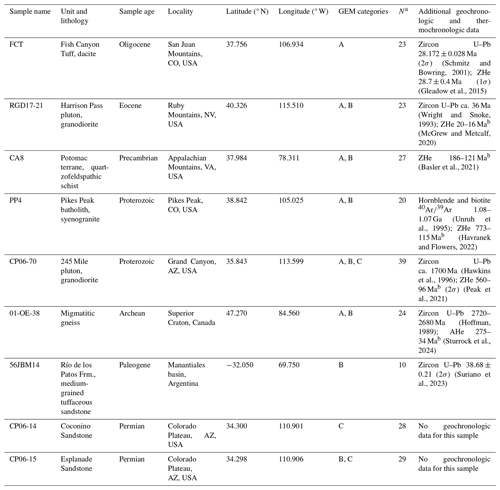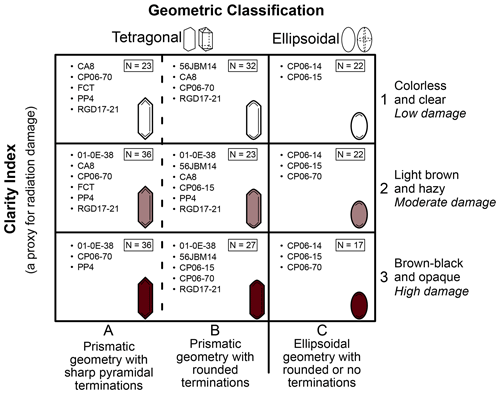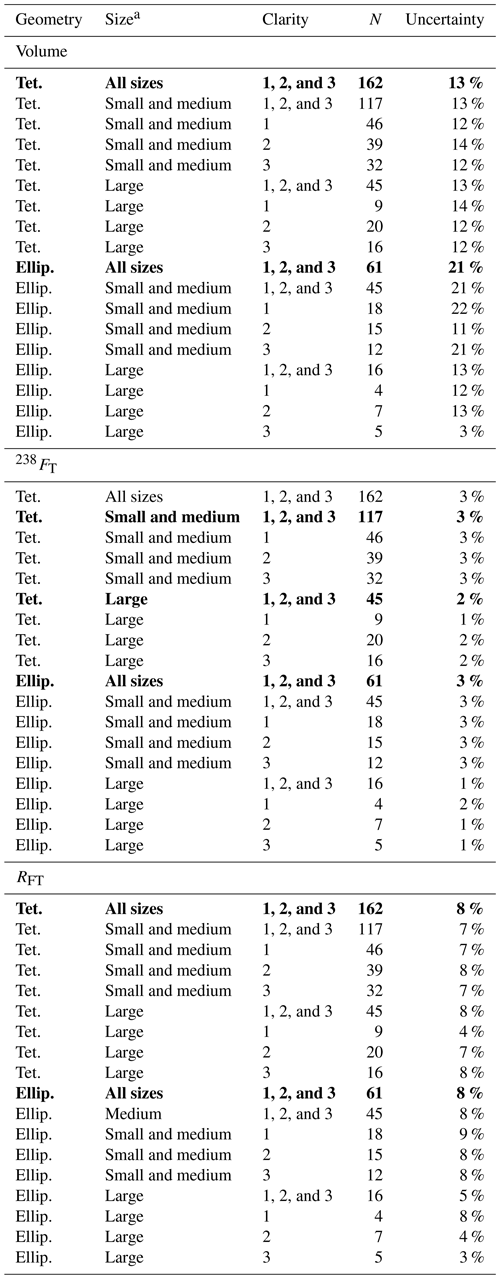the Creative Commons Attribution 4.0 License.
the Creative Commons Attribution 4.0 License.
The Geometric Correction Method for zircon (U–Th) ∕ He chronology: correcting systematic error and assigning uncertainties to alpha-ejection corrections and eU concentrations
Spencer D. Zeigler
Morgan Baker
James R. Metcalf
Rebecca M. Flowers
The conventional zircon (U–Th) He (ZHe) method typically uses microscopy measurements of the dated grain together with the assumption that the zircon can be appropriately modeled as a geometrically perfect tetragonal or ellipsoidal prism in the calculation of volume (V), alpha-ejection correction (FT), equivalent spherical radius (RFT), effective uranium concentration (eU), and corrected (U–Th) He date. Here, we develop a set of corrections for systematic error and determine uncertainties to be used in the calculation of the above parameters for zircon, using the same methodology as Zeigler et al. (2023) for apatite. Our approach involved acquiring both “2D” microscopy measurements and high-resolution “3D” nano-computed tomography (CT) data for a suite of 223 zircon grains from nine samples showcasing a wide range of morphology, size, age, and lithological source, calculating the V, FT, and RFT values for the 2D and 3D measurements and comparing the 2D vs. 3D results. We find that the values derived from the 2D microscopy data overestimate the true 3D V, FT, and RFT values for zircon, with one exception (V of ellipsoidal grains). Correction factors for this misestimation determined by regressing the 3D vs. 2D data range from 0.81–1.04 for V, 0.97–1.0 for FT, and 0.92–0.98 for RFT, depending on zircon geometry. Uncertainties (1σ) derived from the scatter of data around the regression line are 13 %–21 % for V, 5 %–1 % for FT, and 8 % for RFT, again depending on zircon morphologies. Like for apatite, the main control on the magnitude of the corrections and uncertainties is grain geometry, with grain size being a secondary control on FT uncertainty. Propagating these uncertainties into a real dataset (N=28 ZHe analyses) generates 1σ uncertainties of 12 %–21 % in eU and 3 %–7 % in the corrected ZHe date when both analytical and geometric uncertainties are included. Accounting for the geometric corrections and uncertainties is important for appropriately reporting, plotting, and interpreting ZHe data. For both zircon and apatite, the Geometric Correction Method is a practical and straightforward approach for calculating more accurate (U–Th) He data and for including geometric uncertainty in eU and date uncertainties.
- Article
(9211 KB) - Full-text XML
- BibTeX
- EndNote
The conventional whole-crystal technique for zircon (U–Th) He (ZHe) geo- and thermochronology is used for a variety of studies including precisely dating volcanic eruptions (e.g., Danišík et al., 2021), constraining the timing of tectonic exhumation (e.g., Reiners et al., 2002), deciphering sedimentary provenance (e.g., Stockli and Najman, 2020), and inferring erosion associated with unconformity development (e.g., Orme et al., 2016; Flowers et al., 2020). The ZHe method requires microscopy measurements of the zircon length and widths, as well as measurements of parent and child amounts. The microscopy measurements are typically used in conjunction with an idealized geometric model of a tetragonal or ellipsoidal prism (e.g., Ketcham et al., 2011; Fig. 1) to calculate the zircon's volume (V) and surface area. These geometric parameters are then used to compute the alpha-ejection correction (FT), the effective uranium concentration (eU), and the equivalent spherical radius. FT values are necessary to correct ZHe dates for the 4He atoms ejected from the crystal lattice during decay (e.g., Farley et al., 1996; Ketcham et al., 2011). eU (a proxy for radiation damage) is a critical parameter for interpreting ZHe dates because the retentivity of 4He is a function of radiation damage (e.g., Guenthner et al., 2013; Ginster et al., 2019). The equivalent spherical radius approximates the diffusion domain of a whole crystal and is needed for thermal history modeling (here, we use RFT, the radius of a sphere with an FT correction the same as the analyzed grain).
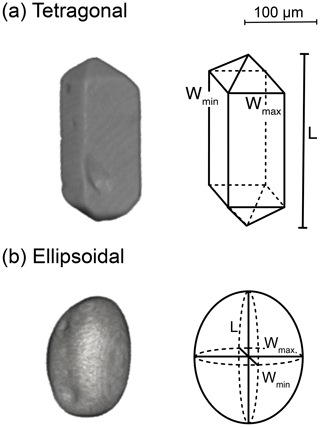
Figure 13D renderings from CT data of real zircon crystals classified as (a) tetragonal and (b) ellipsoidal versus the idealized geometry from Ketcham et al. (2011) that is used to calculate V, FT, and RFT. The scale bar is applicable to both examples of real crystals. Note that the actual grains have geometries that are not perfectly represented by the idealized geometry. The grain length (L), maximum width (Wmax), and minimum width (Wmin) denoted on the schematics of the idealized geometries represent the three grain measurements made using standard 2D microscopy measurements in this study.
Variations in zircon morphology and termination shape can cause real grains to deviate from the perfect geometric prisms assumed by the microscopy method for computing the geometric parameters and associated values (Fig. 1), causing both uncertainty and possibly systematic error in these data. Here, “uncertainty” refers to the measurement reproducibility (i.e., the precision), while “error” refers to the systematic deviation between a measured value and the true value (i.e., the accuracy) (BIPM et al., 2012). Quantifying the uncertainties and systematic error arising from the use of an idealized geometry to calculate geometric parameters is needed to assign appropriate uncertainties to ZHe data and to derive accurate results.
For the mineral apatite, previous work has focused on characterizing and reducing uncertainties and systematic error in the geometric parameters using X-ray micro- or nano-computed tomography (CT) (Herman et al., 2007; Evans et al., 2008; Glotzbach et al., 2019; Cooperdock et al., 2019; Zeigler et al., 2023). CT is a high-resolution, non-destructive method that creates 3D models of scanned objects from which high-quality 3D geometric data such as volume and surface area can be extracted using software like Blob3D (Ketcham, 2005). While CT data have collectively been acquired for several hundred apatite grains over the course of several studies (Herman et al., 2007; Evans et al., 2008; Glotzbach et al., 2019; Cooperdock et al., 2019; Zeigler et al., 2023), only five zircon grains have been analyzed by CT (Evans et al., 2008), and no study has comprehensively addressed uncertainty and error in the zircon geometric parameters.
Here, we fill this gap by (1) presenting high-resolution CT data for 223 zircon grains representative of a wide range of morphology, size, age, and lithologic source and (2) developing a zircon “Geometric Correction Method” to regularly correct for systematic error and assign uncertainties for zircon V, FT, and RFT that can be propagated into the eU value and ZHe date. This work is focused on characterizing the uncertainty and inaccuracy from assumptions about grain geometry only and does not account for additional contributions from parent isotope zonation (e.g., Farley et al., 1996; Hourigan et al., 2005), grain abrasion (e.g., Rahl et al., 2003), grain breakage (He and Reiners, 2022), and zircon density (e.g., Holland and Gottfried, 1955), which have potential to be accounted for separately. This study follows the approach of Zeigler et al. (2023) for apatite and generates a method that similarly involves no added work or cost beyond what is already done as part of most existing (U–Th) He dating workflows and that can be applied retroactively to previously collected data. Like in Zeigler et al. (2023), we first developed a “Grain Evaluation Matrix” (GEM) that classifies grains based on their morphology, acquired “2D” microscopy measurements and high-resolution (sub-1 µm; voxel sizes of 0.84–0.92 µm) “3D” CT data of the same zircon grains, compared the grain dimension measurements, regressed the 3D vs. 2D data, and then determined a set of corrections and uncertainties based on grain geometry and size. While in the past, geometric parameters have not been corrected for systematic error, and uncertainties in a zircon's geometric information have not typically been propagated into eU and ZHe date uncertainties, the Geometric Correction Method provides a straightforward approach for addressing both of these issues. We illustrate the method with real ZHe data to show its importance for the accuracy and precision of ZHe datasets. This study is part of ongoing efforts by the thermochronology community to carefully quantify and account for the different sources of uncertainty in (U–Th) He data (e.g., Martin et al., 2023; Guenthner et al., 2016; Cooperdock et al., 2019; Zeigler et al., 2023; Flowers et al., 2022, and references therein), all of which could then be propagated into the reported uncertainties in (U–Th) He results.
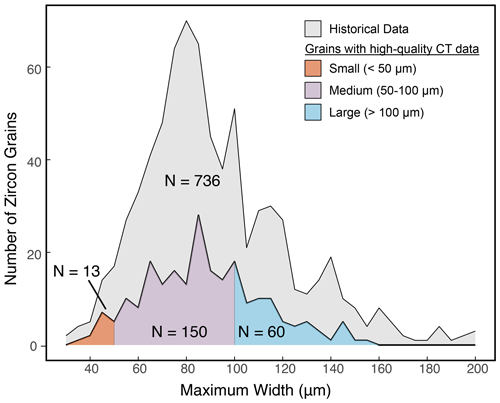
Figure 2The distribution of maximum widths of zircon in this study. Light grey depicts 736 zircon grains dated in the CU TRaIL between 2017 and 2019. Colored shading illustrates the size distribution of all grains for which we acquired high-quality CT data, with the number of grains in each size category listed.
2.1 Strategy
In this study, we selected zircon grains reflecting the full spectrum of zircon characteristics so that the outcomes are applicable to the range of grains commonly dated by (U–Th) He. As described in more detail below, we focused on choosing zircons from a variety of source lithologies and ages (Sect. 2.2), with a range of grain sizes (Sect. 2.3) and morphologies (including grain geometry, number of terminations, and radiation damage) (Sect. 2.4). We originally selected 326 grains for CT analysis and have 223 grains with high-quality CT results in the final dataset.
2.2 Selecting a representative zircon sample suite
The zircon sample suite contains six igneous and metamorphic rocks and three sedimentary samples (Table 1). All samples were separated using standard crushing, density, and magnetic separation techniques. Six of the nine samples were dated previously by ZHe in the University of Colorado Boulder (CU) TRaIL (Thermochronology Research and Instrumentation Lab). The Oligocene Fish Canyon Tuff (sample FCT) has ZHe dates overlapping emplacement (e.g., Dobson et al., 2008; Gleadow et al., 2015). The Eocene Harrison Pass pluton (sample RGD17-21) from the southern Ruby Mountains of Nevada yields Miocene ZHe dates (McGrew and Metcalf, 2020). Three Proterozoic samples include a Neoproterozoic quartzofeldspathic schist from the Central Appalachians (sample CA8) that yields Mesozoic ZHe dates (Basler et al., 2021); the ∼1.1 Ga Pikes Peak granite from Pikes Peak, Colorado (sample PP4) with a span of Cryogenian and younger ZHe dates (Havranek and Flowers, 2022); and a Proterozoic granodiorite from the 245 Mile pluton in the Lower Granite Gorge of the Grand Canyon in Arizona, USA (sample CP06-70), that yields Ediacaran and younger ZHe dates (Peak et al., 2021). Zircon grains from an Archean migmatitic gneiss sample (01-OE-38) from the Superior Craton in Canada that yields Mesozoic and younger ZHe dates (Sturrock et al., 2024) were also included in this study. The three detrital samples include a Neogene sedimentary unit (sample 56JBM14) from the Manantiales basin in Argentina, as well as samples of the Permian Coconino Sandstone (CP06-14) and the Permian Esplanade Sandstone (sample CP06-15) from the Colorado Plateau in northeastern Arizona, USA.
2.3 Selecting a representative zircon crystal size distribution
The size distribution of grains analyzed in this study is based on the size distribution of grains routinely analyzed for (U–Th) He dates. We first plotted the maximum width of all zircon (N=736; Fig. 2) analyzed in the CU TRaIL over a 2-year period. The grains in this compiled dataset were from a variety of sources and were selected and measured by TRaIL staff, TRaIL students, and visitors. Our analysis focused on crystal width because the smallest dimension (i.e., the width) is the chief control on alpha-ejection due to the long stopping distances of alpha particles. These lab analyses were subdivided into small (<50 µm maximum width), medium (50–100 µm maximum width), and large (>100 µm maximum width) size categories (shading in Fig. 2). We based our size categories on the maximum width only for consistency with our complementary apatite study (Zeigler et al., 2023). From the samples described above, we then picked suites of zircon crystals for CT with size distributions that closely matched that in the compiled datasets (Fig. 2). For zircon, the grains in our final dataset range in maximum width from 34 to 153 µm.
2.4 Selecting a morphologically representative zircon crystal suite and designing the zircon Grain Evaluation Matrix
To select a representative zircon sample suite in terms of morphology, first we carefully inspected each sample and noted the variety and proportions of zircon morphological characteristics. In addition to grain shape (euhedral vs. rounded), we noted the grain color, the grain clarity, and the number and shape of the terminations. Termination shapes included pointed terminations like those in the tetrahedral prism of Ketcham et al. (2011), “taco” terminations where the points of the terminations are not centered over the trunk of the grain and are instead off to one side, and “hipped roof” terminations where the terminations end in a ridge rather than a point. Then, when picking the zircon grains for CT analysis, we ensured that the variety of grain morphologies was accurately reflected and that similar percentages of grains with 0, 1, or 2 terminations were included as in the compiled TRaIL zircon dataset (Sect. 2.3).
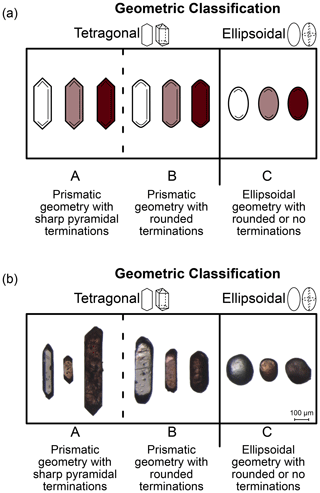
Figure 3The zircon Grain Evaluation Matrix (GEM) in (a) schematic form and (b) with images of real grains analyzed in this study. The geometric axis classifies grains as A, B, or C, where both A and B zircon grains assume an idealized tetragonal prism geometry, while C zircon grains assume an idealized ellipsoidal geometry for 2D calculations (Ketcham et al., 2011).
We used this initial survey of our samples to develop a zircon Grain Evaluation Matrix (GEM), much like that for apatite (Zeigler et al., 2023). The zircon GEM has a single “geometric classification” axis (Fig. 3). The geometry is described as A (tetragonal), B (sub-tetragonal), or C (ellipsoidal). A and B grains assume a tetragonal geometry, while C grains assume an ellipsoidal geometry for 2D geometric parameter calculations (see Sect. 3.2; Appendix A). Zircon grain clarity is known to correlate with radiation damage (e.g., Ault et al., 2018; Armstrong et al., 2024), which influences He retentivity and zircon density, making grain clarity useful information to record during grain selection. We include further discussion of grain clarity and a two-axis zircon GEM in Appendix B, but we do not discuss zircon clarity further in the main text as this parameter does not impact the geometric corrections and uncertainties (Table C2).
3.1 Strategy
To determine corrections for systematic error and appropriate uncertainties arising from traditional 2D microscopy measurements, we compare 2D geometric parameters with 3D geometric parameters acquired via CT. To accomplish this, we first measured our representative sample suite using the conventional 2D microscopy approach (Sect. 3.2) and acquired high-resolution (sub-1 µm) 3D CT data for those same grains (Sect. 3.3). Then, we examined the relationship between 2D and 3D measurements, used linear regression to determine the corrections based on grain geometry (tetragonal vs. ellipsoidal), and calculated the uncertainty (Sect. 3.4). This analysis assumes that the 3D CT measurements are accurate (Sect. 3.3). The uncertainties presented here include only those associated with grain geometry and not those due to parent isotope zonation, grain abrasion, or crystal breakage.
3.2 Microscopy measurements and 2D calculation methods
Zircon grains were hand-picked under a Leica M165 binocular microscope under 160× magnification. Each grain was photographed on a Leica DMC5400 digital camera, manually measured using either the Leica Application Suite X (LAS X) or LAS 4.12 software, and assigned a GEM value (Fig. 3). The calibration of the software was checked before, during, and after the measurements using a micrometer. Photomicrographs were taken under plane-polarized light with the c axis in the same orientation for all crystals to properly assess the color and clarity of the grain. The 2D measurement procedure for zircon is shown in Fig. 4. First, the length was measured parallel to the c axis, and the maximum width was measured perpendicular to the c axis. Then, the grain was rotated 90° onto its side to acquire a second length (parallel to the c axis) and a minimum width (perpendicular to the c axis). The flat-sided habit of zircon makes it straightforward to measure both widths and the grain length accurately, so we used both widths and the average of the two length measurements for the 2D calculations.
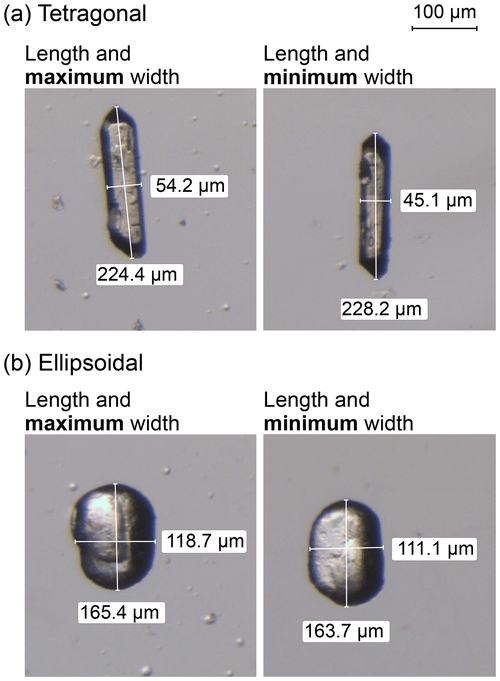
Figure 4Photomicrographs of (a) tetragonal and (b) ellipsoidal zircon grains showing how each grain's (average) length, maximum width, and minimum width were measured for the 2D microscopy measurements. After measuring the first length and maximum width, the grain was rolled 90° onto its side, another photomicrograph of the grain was acquired, and a second length and the minimum width were measured.
The 2D V and isotope-specific FT values were calculated using the equations of Ketcham et al. (2011) and assuming a tetragonal prism geometry for all GEM A and B grains and an ellipsoidal geometry for all GEM C grains. We chose to use the Ketcham et al. (2011) method because the equations can incorporate updated stopping distances in the future without the need for reformulation. RFT calculations used the equations from Cooperdock et al. (2019). Appendix A lists all equations. We used the mean alpha stopping distances for 238U, 235U, 232Th, and 147Sm from Ketcham et al. (2011). The FT calculations of Ketcham et al. (2011) assume that every surface is an ejection surface. For each zircon, we calculated the combined FT value, and the associated RFT value, by assuming a zircon ratio of 0.87 and no Sm contribution, based on the average of the TRaIL zircon sample historical data (N=736 grains) shown in Fig. 2. We made this assumption because the combined FT and RFT values depend on the proportion of each parent isotope contributing to 4He production, and we do not have parent isotope values for the grains analyzed by CT in this study. The assumed ratio does not impact the value of the corrections or uncertainty and is only used for illustrative purposes.
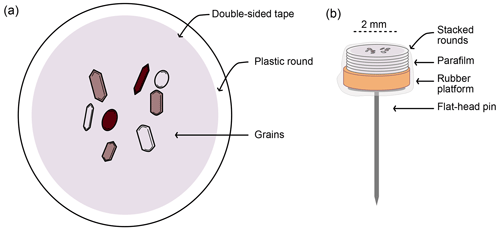
Figure 5Schematic showing (a) an individual plastic round and (b) a final grain mount for CT analysis. Grains are placed onto a ∼2 mm wide sturdy plastic disc (hole punched from a plastic sheet protector) covered with double-sided tape. Each plastic round can hold between 4 and 10 grains. Rounds are stacked on top of each other and placed on a rubber platform cut from old test tube stoppers, which is glued to a flathead pin and covered with Parafilm.
3.3 Nano-computed tomography (CT) and 3D calculation methods
After 2D measurements, zircon grains were mounted for CT. Zircon crystals were mounted in a µm area on a thin, 2000 µm wide plastic disc that was hole-punched from a plastic sheet protector and then covered with double sided tape (Fig. 5). Each plastic disc held 4–10 grains, and 5–6 discs were stacked vertically to create a mount (Fig. 5). Mounts were secured by a thin layer of Parafilm attached to a 1–2 mm thick cylinder of rubber for stabilization and then glued to the head of a flathead pin (Fig. 5).
Each mount was scanned on a Zeiss Xradia 520 Versa X-ray microscope in the University of Colorado Boulder, Materials Instrumentation and Multimodal Imaging Core (MIMIC) facility. During test scans of the first mount, scanning parameters were optimized to reduce noise and scanning artifacts. Scanning parameters were held relatively constant for subsequent mounts with minor adjustments to optimize the trade-off between scan time and resolution (Table B1). All mounts were scanned with the 4× objective lens at high power and voltages, which allowed for high resolution (sub-1 µm).
Raw CT data were processed in Blob3D, following the methods outlined in Zeigler et al. (2023). 3D parameters such as grain dimensions (boxes A, B, and C), V, and isotope-specific FT values were extracted from the data using Blob3D (see Sect. 4.3 in Zeigler et al., 2023). Like the calculations done for 2D RFT values, we calculated 3D RFT values using the equations of Cooperdock et al. (2019) and assuming a ratio of 0.87 based on TRaIL zircon sample historical data. We assume that the CT measurements are representative of the “real” grain measurements because previous work showed that the ±1 % uncertainty in the CT measurements translates to negligible differences in the relevant values output by Blob3D (Cooperdock et al., 2019; Zeigler et al., 2023).
Some zircon grains were removed from the final dataset owing to issues during CT scanning or subsequent data processing. The entirety of zircon mount 2 was excluded due to analytical problems during CT scanning. Three additional zircon grains were excluded owing to 3D models characterized by large holes or with many small gaps that caused the model to be a hollow shell, possibly due to less dense inclusions at the grain edge. The final dataset consists of 223 crystals out of the initial set of 326 grains.

Figure 6Scatterplots of 3D vs. 2D data (N=223) for grain dimension measurements. (a) 3D box A vs. 2D length measurement, (b) 3D box B vs. 2D maximum width measurement, and (c) 3D box C vs. 2D minimum width measurement. The bold black line is the 1:1 line.
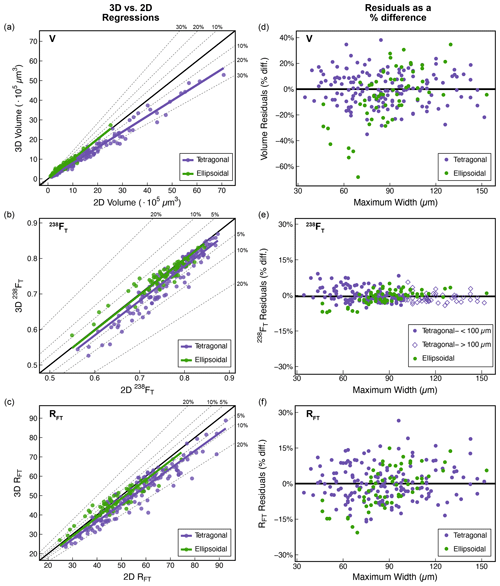
Figure 7Plots illustrating how the corrections for systematic error and how uncertainties were determined for V, FT, and RFT. Scatterplots of 3D vs. 2D data (N=223) with regression lines and data distinguished by geometry for (a) V, (b) 238FT, and (c) RFT. The bold black line is the 1:1 line, and the dashed lines mark the percent difference from the 1:1 line. Note that for all regressions (except for the volume and FT of ellipsoidal grains), the regression line falls below the 1:1 line, indicating that the 2D microscopy data overestimate the 3D CT data. The 2D data can be corrected for systematic error by multiplying the 2D data by the slope of the regression line. Scatterplots of the difference in each 2D value from the regression line (i.e., the residual) as a percent difference vs. maximum width with data distinguished by geometry for (d) V, (e) 238FT, and (f) RFT. For 238FT, the tetragonal grains are additionally split by <100 µm maximum width (small- and medium-sized grains in Fig. 2) and >100 µm maximum width (large-sized grains in Fig. 2). The bold black line is 0 % difference. Note the larger y axis scale for V compared with 238FT and RFT, reflecting the greater uncertainty in V. The standard deviation of the percent difference in the residuals of each group is the uncertainty in the parameter.
3.4 Statistical comparison of 2D and 3D values
The first step in our statistical analysis was to create scatterplots of the 3D vs. 2D values for the grain dimensions (Fig. 6), V, FT, and RFT (Fig. 7). In Fig. 7, we only show the results for 238FT because it dominates the 4He budget, but the results for each isotope (235U, 232Th, and 147Sm) are in Fig. C1. For completeness, we include the 147FT value, but 147Sm is commonly not measured in zircon because of its negligible incorporation into this mineral and insignificant contribution to ZHe dates. Although surface area is a parameter output by Blob3D, we did not consider it separately because surface area alone is not used to calculate any parameters.
We next regressed the 3D vs. 2D data for each parameter. If the data plot on the 1:1 line (bold black line) on the 3D versus 2D plots, then no correction for systematic error is needed for the 2D data because the 2D and 3D data agree. However, if the data plot above or below the 1:1 line, then the correction desired for the 2D data can be viewed as the offset of the data and its linear regression line from the 1:1 line. To determine the corrections for systematic error (e.g., the slope of the regression), we followed the procedure outlined in Sect. 4.4 of Zeigler et al. (2023) and used a simple, ordinary least squares linear regression with the intercept fixed at 0.
We tested different groupings of physical parameters for the linear regressions to assess which groups yielded statistically different slopes (i.e., corrections for systematic error) using Tukey's highly significant difference test. The results of this analysis are in Table C1. We found that the slopes were statistically indistinguishable when regressions were grouped by size (medium and small (<100 µm) vs. large (>100 µm)) or clarity (1, 2, or 3; Fig. B1), but a significant difference was found between the slopes for GEM A and B (tetragonal) and GEM C (ellipsoidal) zircon grains. Therefore, the regressions are grouped by grain geometry for all geometric parameters.
The uncertainty for V, FT, and RFT is the scatter of the data around the regression line. To quantify the uncertainty, we used the approach of Zeigler et al. (2023) and computed the 1σ standard deviation of the residual values of the points from the regression line, plotted as residual percent difference versus maximum width for each parameter (Fig. 7d–f). The standard deviations for different groups of physical variables (e.g., size and clarity) were compared to evaluate potential relationships with uncertainty (Table C2). We used Pearson's r to calculate the correlation coefficient between each isotope-specific FT uncertainty (Martin et al., 2023).
Table 2Corrections and uncertainties (1σ) for all geometric parameters.
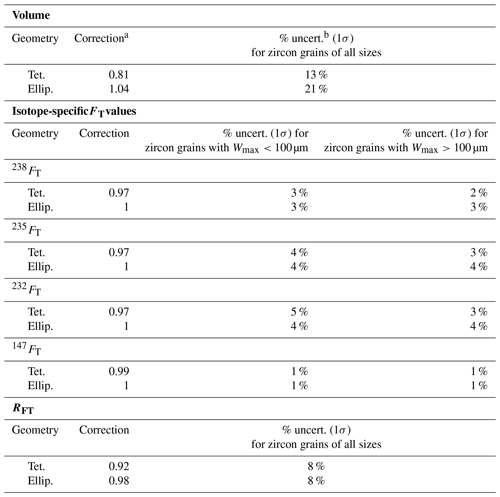
a The correction value is the slope of the 3D vs. 2D regression line for each parameter in Figs. 7a–c and C1a–c. b The uncertainty is the scatter of the 2D data around each regression line in Figs. 7a–c and C1a–c, calculated as the 1σ standard deviation of the percent difference in each 2D value from the regression line (Figs. 7d–f and C1d–f).
Table 32D microscopy and 3D CT data comparison for this studya.
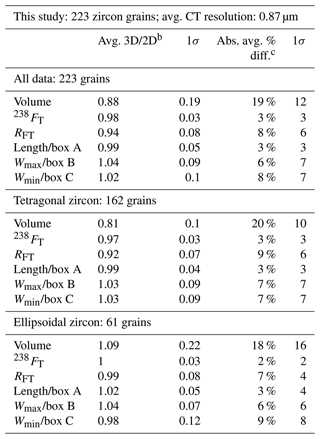
a Directly follows the structure of Table 3 reported in Cooperdock et al. (2019) and Table 3 in Zeigler et al. (2023) to facilitate comparison with previous studies on apatite.
b Avg. 3D/2D is the average of 3D/2D values in this study.
c Abs. avg. % diff. is the average absolute percent difference between the 2D and 3D data. We used the formula to calculate the percent difference for consistency with Cooperdock et al. (2019) and Zeigler et al. (2023).
For zircon dimension data, the 3D values closely match the 2D values for length (box A), maximum width (box B), and minimum width (box C) (Fig. 6a–c). The average 3D/2D value and average absolute percent differences are 0.99 and 3 % for length/box A, 1.04 and 6 % for maximum width/box B, and 1.02 and 8 % for minimum width/box C (Table 3). 2D measurements are generally accurate for zircon, owing partially to its rectangular habit which makes 2D measurements relatively straightforward. Outliers in Fig. 6 can be attributed to grains with uneven terminations, sharp broken angles, or otherwise unusual morphologies which can cause Blob3D to measure dimensions different from the c axis parallel length and perpendicular widths used in the 2D measurements (Cooperdock et al., 2019).
The 3D vs. 2D scatterplots for zircon V, FT, and RFT show data that systematically plot below the 1:1 line (bold black line) with two exceptions (V and FT of ellipsoidal grains), indicating that for almost all parameters, the 2D values overestimate the true 3D values. The 2D data can be corrected for their offset from the 3D data by multiplying the 2D data by the slope of the 3D vs. 2D data so that the 2D data are centered around the 1:1 line, thereby “correcting” them. As noted in Sect. 3.4, regressions of the 3D vs. 2D data are separated by geometry because the regressions of tetragonal and ellipsoidal grains yield statistically distinguishable slopes. The corrections for systematic error for zircon V, FT, and RFT are summarized in Table 2. For all parameters, the magnitude of the correction is larger for tetragonal grains than for ellipsoidal grains (Table 2; e.g., for FT, a 0.97 correction for tetragonal grains vs. no correction for ellipsoidal grains).
The uncertainties for V, FT, and RFT are derived from the scatterplots of percent difference in the residuals versus maximum width in Fig. 7d–f, where the bold black line represents a 0 % difference between the 2D and 3D data. The uncertainties are separated by geometry for all parameters because the residuals are derived from the regression lines which group the data in this way (Table 2). A single uncertainty is reported for ellipsoidal zircons for all parameters due to the relatively small number of ellipsoidal grains in the dataset (N=61). However, because the size of the tetragonal dataset was large (N=162), we explored different uncertainty groupings (Table C2). For V and RFT, neither grain size nor clarity had a consistent or clear relationship with uncertainty (Table C2). However, for FT, grain size and uncertainty are related, with larger uncertainty for smaller grain size. For all parameters, the uncertainty for tetragonal grains is smaller than or equal to the uncertainty for ellipsoidal grains (Table 2). For example, for V, the uncertainties for tetragonal and ellipsoidal grains are 13 % and 21 %, respectively. As anticipated, the isotope-specific FT uncertainties are correlated, yielding correlation coefficients of 0.79–0.99.
5.1 Accuracy and precision of 2D geometric data
The aim of this study was to use the approach of Zeigler et al. (2023) for apatite to develop corrections for systematic error and assign uncertainties to geometric parameters estimated from microscopy measurements for the full range of zircon grains regularly dated by (U–Th) He (Table 2). Previous studies of apatite reported the average 3D/2D value and its 1σ uncertainty as a measure of systematic error and reported the average absolute percent difference between the 2D and 3D data and the 1σ uncertainty as a measure of the uncertainty in each parameter (Cooperdock et al., 2019; Zeigler et al., 2023). For consistency with this past work, we additionally report our zircon results in this way (Table 3).
For V, tetragonal zircon 2D values overestimate the true grain volume (correction value of 0.81) with an uncertainty of 13 %, while ellipsoidal zircon 2D values underestimate the volume (correction value of 1.04) with an uncertainty of 21 % (based on the regressions; Table 2). The average 3D/2D values and average absolute percent difference for our whole dataset are 0.88 and 19 %, respectively (Table 3). Our results agree with those of a study that compared tetragonal zircon masses calculated by traditional microscopy measurements with those determined stoichiometrically by isotope–dilution inductively coupled plasma–mass spectrometry (ICP-MS) analysis of Zr, which found that 2D values overestimate the stoichiometric results with an average percent difference of 25 % between the two methods (Guenthner et al., 2016).
For FT, our 2D values slightly overestimate, or are the same as, the 3D values. The isotope-specific 238FT has a 2D correction of 0.97 for tetragonal grains and no correction for ellipsoidal grains, with uncertainties of 2 %–3 %, depending on geometry and size (Table 2). Our average 3D/2D value for 238FT is 0.98, with an absolute average difference of 3 % (Table 3).
For RFT, 2D measurements are systematically larger than 3D measurements (correction values of 0.92 and 0.98), with an uncertainty of 8 % for both tetragonal and ellipsoidal grains (Table 2). Our average 3D/2D value for RFT is 0.94, with an average difference of 8 % (Table 3).
We find that the same parameters control the corrections and uncertainties for zircon (this study) as for apatite (Zeigler et al., 2023). Grain geometry is the primary control on the corrections for systematic error. The choice of categorizing zircon as GEM A, B, or C dictates the choice of idealized geometry (tetragonal or ellipsoidal), which in turn determines the correction. The correction for tetragonal grains is larger than for ellipsoidal grains for all parameters, indicating that the tetragonal idealized geometry does a systematically poorer job than the idealized ellipsoidal geometry at representing the true grain morphology. Part of the reason for this is that the equations used for the idealized tetragonal geometry assume a specific angle (45°), length, and shape for the terminations (Ketcham et al., 2011), while the terminations of real zircon grains have a variety of shapes and angles.
The uncertainties are controlled primarily by grain geometry, while grain size is a second-order control for the FT uncertainty only. The pattern of smaller uncertainties for tetragonal than ellipsoidal grains (Table 2) implies that there is less variability in the morphology of tetragonal than ellipsoidal zircon grains. This may be related to ellipsoidal zircon grains commonly being detrital and therefore more likely to have irregularities than their pristine tetragonal counterparts. For FT, grain size exerts an additional influence on the uncertainty in the tetragonal zircon, decreasing from 3 % to 2 % for medium and small (maximum width <100 µm) and large (maximum width >100 µm) grains, respectively, with an uncertainty of 3 % for ellipsoidal grains of all sizes. The influence of grain size on FT uncertainty is expected because the uncertainty in a microscopy measurement is proportionally larger for smaller measurements.
Overall, the corrections and uncertainties for zircon (this work) are similar to or smaller than those for apatite (Zeigler et al., 2023). We attribute this pattern to the greater ease of acquiring an accurate 2D microscopy measurement of the zircon minimum width than the apatite minimum width. For tetragonal zircon, the flat-sided habit makes it straightforward to roll the grain 90° into a stable position for the minimum width measurement. However, for hexagonal apatite, the more rounded habit makes it challenging to stabilize the grain for a minimum width measurement, resulting in greater uncertainty and error in this 2D value and the 2D parameters computed from this measurement.
5.2 Implications: how much do the zircon geometric corrections and uncertainties matter?
5.2.1 Overview
To determine how much the geometric corrections and uncertainties (Table 2) affect the values and uncertainties in real ZHe data, we follow the approach of Zeigler et al. (2023) for apatite and apply our corrections and uncertainties to the V, FT, and RFT values of representative zircon grains from five samples (N=28), four of which were used in this study and all of which were previously dated in the CU TRaIL (Tables D1–D3). This set of zircon includes tetragonal and ellipsoidal grains with a range of sizes. We then use the corrected V and isotope-specific FT values to calculate the mass, eU, and the corrected ZHe date and propagate the geometric uncertainties in V and FT into the uncertainties in these derived values. HeCalc (Martin et al., 2023) was used for uncertainty propagation into the corrected ZHe date assuming fully correlated (r=1) isotope-specific FT uncertainties, which is the conservative approach that yields the maximum uncertainty. We then compare the Geometric Correction Method (GCM) values and uncertainties in all parameters with their 2D-uncorrected counterparts (Sect. 5.3.2–5.3.5) and generate corrected ZHe date vs. eU plots with both the GCM and 2D values (Fig. 8).
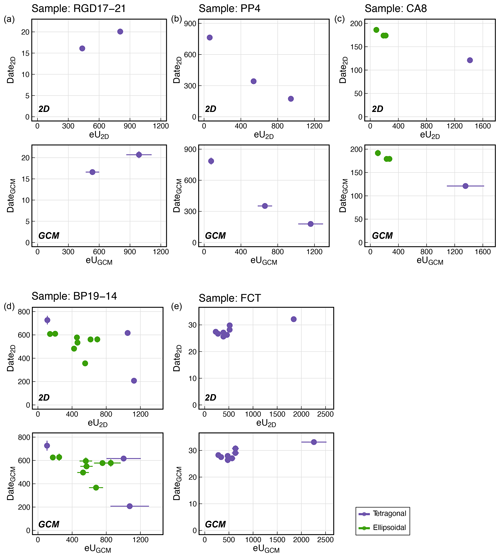
Figure 8ZHe date–eU plots for five samples previously dated in the CU TRaIL, showing the effects of corrections and uncertainty estimates on typical ZHe data. The top plot for each sample (2D) shows ZHe date2D vs. eU2D plots with only analytical uncertainties propagated into the date uncertainty and no eU uncertainty shown. The bottom plot for each sample (GCM) shows ZHe dateGCM vs. eUGCM plots with both analytical and geometric uncertainties propagated into the date uncertainty and geometric uncertainties included on eU uncertainty. When uncertainty bars are not visible, they are smaller than or similar to the symbol size. An idealized tetragonal geometry was used for 2D geometric parameter calculations for the zircon represented by purple circles, while an idealized ellipsoidal geometry was used for the zircon represented by green circles.
Table 4The average percent difference between the 2D and GCM values for example dataset in Tables D1–D3.

n/a indicates “not applicable”; for example, mass does not have any analytical uncertainty in the parent isotopes.
a There are N=24 tetragonal and N=4 ellipsoidal grains.
b The average of the GCM parameter (calculated using the GCM values) divided by the average of the 2D values (calculated using the 2D values) for the example data in Tables D1–D3. Values smaller than 1 indicate that the 2D value is larger than the GCM value. Values greater than 1 indicate that the 2D value is smaller than the GCM value.
c The average of the percent total analytical uncertainties (TAUs) (i.e., parent isotope) only for the example data in Tables D1–D3.
d The average of the percent TAU + geometric (GCM) uncertainties for the example data in Tables D1–D3.
e The average percent increase is the difference between the TAU-only and TAU + GCM uncertainties.
The average GCM/2D values for this dataset are in Table 4. All uncertainties in Table 4 and the discussion below are reported at 1σ. Over the last several years, standard practice in the CU TRaIL has been to report 15 % 1σ uncertainties in eU based on estimates by Baughman et al. (2017). However, how eU uncertainties are reported varies for different labs, with no uncertainty commonly reported for eU data. Therefore, no uncertainty is shown for eU2D values in the top plot for each sample in Fig. 8, and none is reported in Table D1.
5.2.2 Mass and eU
eU is calculated from the parent isotope concentrations, which are computed using the absolute amounts of the parent isotopes and the zircon mass. Mass is computed from V assuming a zircon density (here we use 4.65 g cm−3). Conventionally, the grain mass reported by labs has had no uncertainty attached to it because the geometric uncertainty in V (and thus on mass) was not well known. By applying a correction factor to V based on grain geometry (0.81 or 1.04) and calculating mass using the corrected V, the massGCM decreases for tetragonal grains and increases for ellipsoidal grains by the same correction factor as the volume. The mass then inherits the same percent uncertainty as volume (13 % or 21 % (1σ), depending on geometry).
For eU, the smaller massGCM values for tetragonal grains (relative to mass2D) mean larger eUGCM values (relative to eU2D), while the larger massGCM values for ellipsoidal grains (relative to mass2D) mean smaller eUGCM values (relative to eU2D). In our example dataset (Table 4), the average eU is 1.23 for tetragonal grains and 0.96 for ellipsoidal grains. We propagated the analytical uncertainties in the parent isotopes only, as well as on both the parent isotopes and geometric uncertainties, into the eUGCM values. Including parent isotope uncertainties only yields average eU uncertainty values of 3 % and 5 % for tetragonal and ellipsoidal zircon, respectively. Propagating both analytical and geometric uncertainties yields average uncertainties of 12 % and 20 % for tetragonal and ellipsoidal zircon, respectively.
5.2.3 Combined FT values
The combined FT values are calculated using both the parent isotope amounts and the isotope-specific FT values. For our example dataset, we apply the correction factors in Table 2 based on grain geometry and size to the isotope-specific FT values and then use these corrected values to compute the combined FT,GCM value. FT,GCM is smaller than FT,2D for tetragonal grains and is the same as FT,2D for ellipsoidal grains ( and 1 for tetragonal and ellipsoidal grains; Table 4).
FT values have not typically been reported with an uncertainty because the geometric uncertainty in FT has been poorly constrained until now. We propagated uncertainties into the combined FT value using the parent isotope uncertainties only, as well as using both parent isotope and geometric uncertainties. For the example dataset, including analytical uncertainties only yields average uncertainties in the combined FT value of 2 % and 4 % for tetragonal and ellipsoidal zircon, respectively. Propagating both parent isotope and geometric uncertainties generates average values of 3 % and 5 % for the two geometries.
5.2.4 Corrected zircon (U–Th) He dates
We calculated FT-corrected ZHe dates iteratively with an age equation that incorporates the isotope-specific FT corrections (Ketcham et al., 2011). For the ZHe dates of our example dataset, the smaller FT,GCM values for tetragonal grains (relative to FT,2D) mean larger corrections for alpha-ejection and dateGCM values that are older than the date2D values (avg. dateGCM date2D=1.03), while for ellipsoidal grains the ZHe dateGCM values are unchanged from the date2D values (avg. dateGCM date2D=1.00).
We calculated the uncertainty in the corrected (U–Th) He dates first by propagating the analytical uncertainties in the parent and child only and then by additionally including the geometric uncertainties in the isotope-specific FT,GCM values and assuming fully correlated FT,GCM uncertainties (Table 4). For this dataset, propagating only analytical uncertainties yields average uncertainties of 3 % and 4 % for tetragonal and ellipsoidal grains, respectively. Including both analytical and geometric uncertainties yields average uncertainties of 4 % and 5 % for the two geometries.
5.2.5 RFT
We applied the correction factors based on grain geometry in Table 2 to RFT values from the example dataset. The RFT,GCM values are always smaller than RFT,2D values ( and 0.98 for tetragonal and ellipsoidal grains) (Table 4). The uncertainty in RFT is 8 % (1σ) for both geometries. RFT is used during thermal history modeling, and this uncertainty should be included in modeling when possible.
5.2.6 Summary
Like for apatite, correcting ZHe data for systematic error and propagating appropriate geometric uncertainties has substantial influence on eU but less influence on the ZHe date. For eU, the GCM values of the example dataset increase by 9 %–15 %, causing a noticeable shift in the data to the right (higher eU values) on the date–eU plots (compare the top and bottom plots for each sample in Fig. 8). When both analytical and geometric uncertainties are included, eU uncertainties average 12 % and 20 % for the different grain geometries, indicating the importance of appropriately reporting, representing, and considering eU uncertainties when interpreting ZHe datasets. For the corrected ZHe date, for tetragonal grains the ZHe dateGCM values are on average 3 % older than the date2D values, with no change for ellipsoidal grains. Typical ZHe date uncertainties increase by only 1 % for both geometries when geometric uncertainties are propagated in addition to analytical uncertainties.
5.3 The zircon Geometric Correction Method: a practical workflow
Like for apatite (Zeigler et al., 2023), the Geometric Correction Method for zircon shown in Fig. 9 can be easily integrated into existing (U–Th) He dating workflows with no additional time, cost, or equipment. The final corrections and uncertainties are most appropriate for grains with characteristics like those used in this calibration study, with microscopy measurements and 2D calculations done as in this work. Zircon grains ideally should have geometries like those in Fig. 3, length/maximum width ratios of 1.0–8.0, minimum width/maximum width ratios of 1.0–1.9, and maximum widths between 34 and 160 µm. All equations required for the calculations are in Appendix A. The corrections for systematic error and uncertainties reported here are only those from grain geometry. For FT, additional inaccuracy and uncertainty may be caused by parent isotope zonation (e.g., Farley et al., 1996; Hourigan et al., 2005), grain abrasion (e.g., Rahl et al., 2003), and grain breakage (He and Reiners, 2022). For mass and the derived eU values, additional uncertainty may be introduced by radiation damage, which can cause the zircon density (used to calculate mass) to drop by up to 16 % (e.g., Holland and Gottfried, 1955). As additional sources of uncertainty are characterized, these too can be propagated into the uncertainties in the (U–Th) He data. The following workflow is the same as that for apatite but modified slightly for zircon.
Step 1. Select zircon grain geometry and GEM category.
Choose a zircon grain for analysis. Decide whether the grain is tetragonal or ellipsoidal, which is all that is required to correct the 2D values and assign uncertainty. However, we encourage taking additional notes on the zircon clarity and other characteristics (Figs. 3, B1) which can be helpful for data interpretation.
Step 2. Measure the zircon.
Measure the zircon using the procedure outlined in Sect. 3.2 and Fig. 4.
-
Measure the grain length parallel to the c axis. Only a single length is required, but if the grain has an extremely angled or uneven end, then measuring and averaging two lengths may better capture the average length.
-
Measure the zircon grain's maximum width, which is perpendicular to the grain length. Note that the maximum width is a factor for selecting the proper FT,GCM uncertainty (see Step 5; Table 2).
-
Rotate the zircon 90°, and measure the zircon's minimum width.
Step 3. Calculate the zircon's 2D values.
Calculate 2D microscopy V and isotope-specific FT values using the tetragonal or ellipsoidal equations of Ketcham et al. (2011) and calculate RFT using the equations of Cooperdock et al. (2019). The parent isotope data must first be acquired for the FT and RFT values to be computed.
Step 4. Correct the 2D values.
Multiply the 2D microscopy V, isotope-specific FT, and RFT values by the correction factor based on the grain geometry to produce the VGCM, FT,GCM, and RFT,GCM values (Table 2).
Step 5. Assign uncertainty.
Assign the uncertainty value to each parameter according to the grain geometry (for VGCM, FT,GCM, RFT,GCM) and maximum width (for FT,GCM) (Table 2).
Step 6. Calculate derived parameters and propagate uncertainties.
-
Compute mass and eU using the VGCM values. Uncertainty in V should be propagated into the uncertainties in these derived parameters.
-
Compute corrected (U–Th) He dates using the isotope-specific FT,GCM values. Uncertainty in FT should be propagated into the final uncertainty in the corrected He date. This uncertainty propagation can be accomplished, for example, using the open-access Python program HeCalc for (U–Th) He data reduction (Martin et al., 2023).
For example, a zircon selected for analysis has a maximum width of 89 µm, a GEM value of A, and a 238FT,2D value of 0.81 (see Appendix A and the footnotes of Tables D1–D3 for the details of this calculation). The analyst uses Table 2 to select the correction for tetragonal grains (0.97) and calculates correction = . The analyst then selects the proper uncertainty from Table 2; this tetragonal grain is considered medium-sized because it is 89 µm wide, so it has a geometric uncertainty of 3 %. The final % if only the geometric uncertainty is propagated into the 238FT value. This procedure is repeated for each isotope-specific FT,2D value. The isotope-specific FT,GCM values are used to calculate the corrected ZHe date, and both the uncertainty in each isotope-specific FT and the analytical uncertainty in the parent and child isotopes are propagated into the uncertainty in the corrected (U–Th) He date.
In this paper, we develop a set of corrections for systematic error and assign uncertainties to zircon geometric parameters calculated from 2D microscopy measurements. The uncertainties in these geometric parameters (V and isotope-specific FT values) and the data derived from them (mass, eU, combined FT, corrected (U–Th) He date, and RFT) have not traditionally been included in reported uncertainties in ZHe data but are important for appropriate representation and interpretation of such datasets. This study builds on the work of Zeigler et al. (2023) for apatite and similarly presents the only no-cost, easy-to-implement, and backwards-compatible solution to this problem but for zircon. It is straightforward to incorporate the Geometric Correction Method (GCM) into existing workflows (Fig. 9) and to apply it to previously published data. These corrections and uncertainties are most appropriate for zircon grains like those in this calibration study, with microscopy measurements and parameter calculations performed as in this work. This study uses the Ketcham et al. (2011) equations for computing the geometric parameters. Other methods for computing the volume and surface area of zircon crystals are available that incorporate measurements of the pyramidal termination height (e.g., Reiners et al., 2005; Hourigan et al., 2005), but this does not preclude the application of our corrections and uncertainties to these datasets because the mean length and width of the zircon crystals can be derived from the reported measurements and incorporated into the Ketcham et al. (2011) calculations if desired.
The corrections and uncertainties in this study were derived from the regression of 2D and 3D measurements of 223 zircon grains displaying the range of morphologies commonly dated by (U–Th) He. The derived corrections and uncertainties were then applied to real ZHe data to determine their typical impact. The key outcomes are as follows:
-
Both uncertainty and systematic error are associated with the microscopy approach to calculating V, FT, and RFT for zircon, but the magnitudes are slightly smaller than they are for apatite.
-
Using 2D microscopy measurements, the true values of V are overestimated for tetragonal grains and underestimated for ellipsoidal grains, the true values of FT are slightly overestimated (tetragonal zircon) or correctly determined (ellipsoidal zircon), and the true values of RFT are overestimated for both geometries.
-
All corrections for systematic error are larger for tetragonal than for ellipsoidal grains, but all uncertainties are the same or smaller for tetragonal than for ellipsoidal grains. V has the largest magnitude of overestimation and uncertainty, followed by RFT and then FT.
-
For a subset of real ZHe data (N=28 analyses), the correction factor for eU typically increases the eU by ∼20 % (for tetragonal grains) and decreases eU by ∼4 % (for ellipsoidal grains), with associated 1σ uncertainties of 12 %–20 % when both analytical and geometric uncertainties are included. These shifts in eU values and the uncertainty magnitudes are substantial and should be considered when interpreting ZHe data.
-
For the real dataset, the correction factor for the corrected (U–Th) He date generally increases the date by 3 % for tetragonal grains, with associated 1σ uncertainties of 4 %–5 % if both analytical and geometric uncertainties are included. Application of the GCM to ellipsoidal grains does not change the corrected ZHe date but does increase the associated 1σ uncertainties by 1 %.
-
The geometric corrections and geometric uncertainties are substantial enough, while being simple enough to account for, that they should be routinely included when reporting eU and corrected ZHe dates.
All equations necessary to use the corrections and uncertainties are listed below.
Equations (A1) to (A4) are for a tetragonal (GEM A or B) grain from Ketcham et al. (2011), where we use Wmin instead of a, Wmax instead of b, and L instead of c. Here, S is the weighted mean stopping distance of an alpha particle for a given parent isotope decay chain (15.55, 18.05, 18.43, and 4.76 µm for 238U, 235U, 232Th, and 147Sm, respectively), RSV is the equivalent surface-to-volume ratio spherical radius, and Np is the number of pyramidal terminations. Equation (A4) is used to calculate each isotope-specific FT value, each with a different stopping distance (S).
Equations (A5) to (A8) are for an ellipsoidal grain (GEM C) from Ketcham et al. (2011). In Ketcham et al. (2011), the axes a, b, and c refer to the semi-axis lengths for ellipsoidal grains (e.g., half of the full-axis length). We use Wmax, Wmin, and L as the full-axis length, hence the division by 2. Equation (A8) is used to calculate each isotope-specific FT value, each with a different stopping distance.
The age equation from Ketcham et al. (2011) is as follows:
Equations (A10) to (A15) are for combined FT and RFT from Cooperdock et al. (2019). Here, S238, S232, and S235 are the weighted mean stopping distances for each decay chain in zircon, using the values noted above. A238 and A232 are the activities of 238U and 232Th, respectively.
Equation (A16) is for eU from Cooperdock et al. (2019).
The zircon-GEM was initially designed with two axes, namely a “geometric classification” x axis and a “clarity index” y axis (Fig. B1). Zircon grain clarity was initially considered because this characteristic correlates with radiation damage (e.g., Ault et al., 2018; Armstrong et al., 2024), which influences zircon He retentivity (and therefore the ZHe date) and zircon density (and therefore the estimated mass and eU values). Grain clarity thus can be useful information to record during grain selection and is retained in the two-axis zircon GEM (Fig. B1). We chose to use a small number of discrete categories for grain clarity due to the difficulty and inconsistency between analysts of categorizing grains into finer categories. However, zircon clarity does not impact geometric corrections and uncertainties (Table C2), so the zircon GEM was collapsed to a single geometric classification axis, as shown in the main text (Fig. 3).
The GEM can be used to easily and consistently classify individual zircon grains, or entire separates, when picking. Additionally, both the two-axis zircon GEM presented here (Fig. B1) and the apatite GEM (Fig. 3 in Zeigler et al., 2023) are useful tools for newcomers to mineral picking as they simply display the wide variety of pickable zircon and apatite.
Table B1Zircon CT scan parameters.
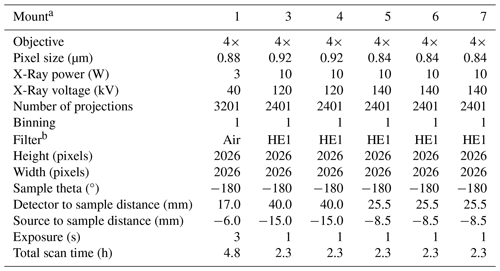
a Mount 2 is excluded from this dataset (see Sect. 3.3 for details). b HE1 is a filter provided by Zeiss that is used to avoid beam-hardening artifacts.
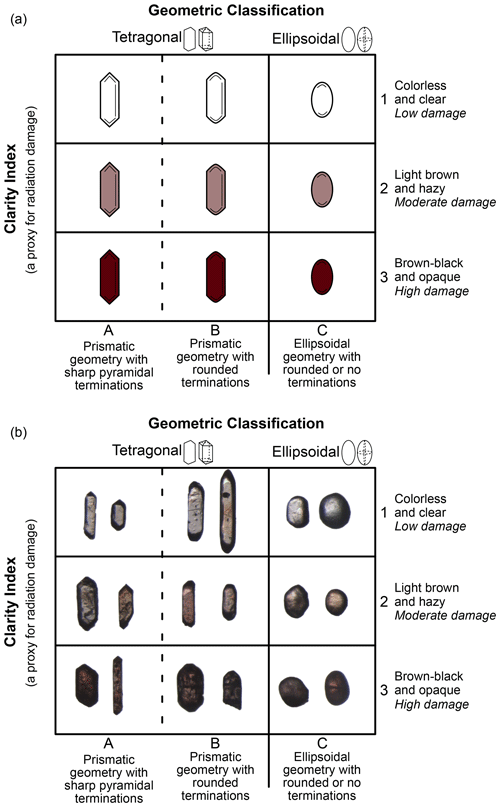
Figure B1The expanded Grain Evaluation Matrix (GEM) for zircon in (a) schematic form and (b) with images of real zircon analyzed in this study. The geometric classification axis is the same as in Fig. 3. The clarity index axis measures the zircon color and opacity as a qualitative proxy for radiation damage. Darkness and opacity increase from 1 (colorless and clear) and 2 (light brown and hazy) to 3 (brown–black and opaque). The GEM in Fig. 3 collapses the clarity axis since radiation damage does not influence the regressions. Users are encouraged to note the color and clarity of the zircon grain as a qualitative proxy for radiation damage, which bears on the interpretation of ZHe data. Grains can be described by combining a geometric value and a clarity value (e.g., A1 and B2).
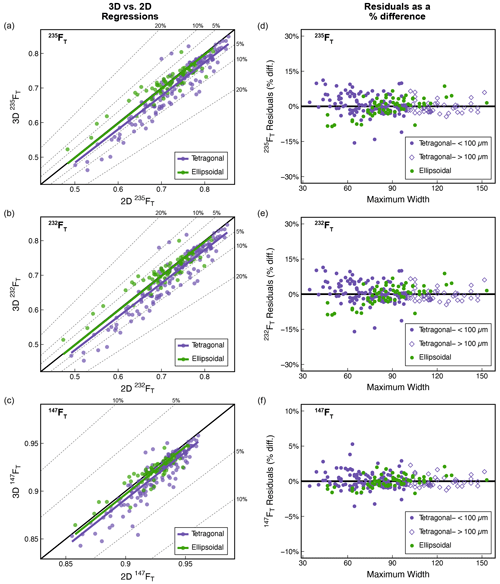
Figure C1Plots illustrating how the corrections for systematic error (a–c) and how uncertainties (d–f) were determined for different parent isotope-specific FT values. This figure is the same as Fig. 7b and e for 238FT but for the 235FT, 232FT, and 147FT values.
Table C1Results of Tukey's highly significant differencea test to determine if different groups of grains have statistically different slopes.
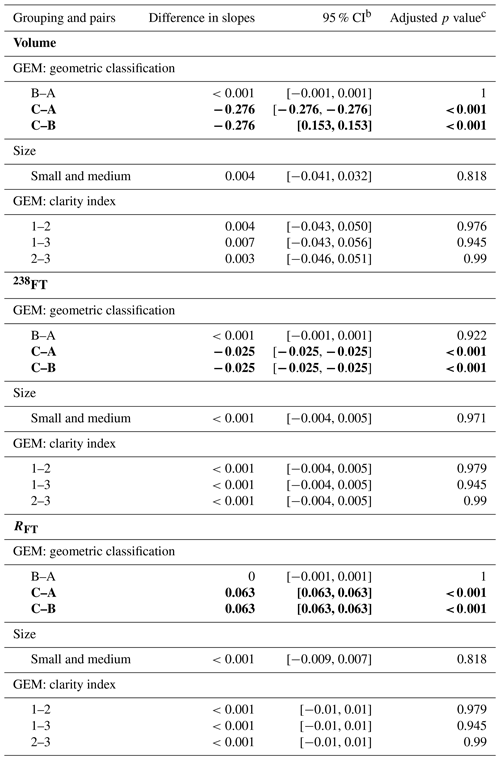
a Tukey's highly significant difference tests if slopes are significantly different from each other or not and takes into account the uncertainties in the slopes, where the null hypothesis, H0, is β1=β2, and the alternative hypothesis, H1, is β1≠β2.
b The 95 % confidence interval (CI) of the difference in slopes.
c A p value <0.05 indicates that H0 can be rejected; i.e., there is a significant difference between the slopes of the pair. If the p value is >0.05, then this indicates that there is no significant difference between the means of the pair. Bolded pairs of slopes are those with p values <0.05 and therefore are treated as separate groups.
Table D1Results of applying geometric corrections and uncertainties (1σ) to zircon (U–Th) He data from a suite of samples previously dated in the CU TRaIL for mass and eU.

All uncertainties reported at the 1σ level.
a All RGD17-21, PP4, CA8, and BP19-14 data are published in McGrew and Metcalf (2020), Havranek and Flowers (2022), Basler et al. (2021), and Peak et al. (2023), respectively.
b Geometry is defined as described in Fig. 3 of Ketcham et al. (2011). All GEM A and B grains are tetragonal (tet.) (“tetrahedral prism” in Ketcham et al., 2011) and all GEM C grains are ellipsoidal (ellip.).
c Maximum width is measured perpendicular to the length.
d Mass2D is the mass of the crystal determined by 2D microscopy measurements, the volume assuming the reported grain geometry, and the volume equations and mineral densities in Ketcham et al. (2011).
e MassGCM is computed the same as mass2D, but the 2D V is corrected by applying the correction factor in Table 2 based on the grain geometry, and this new volume is used in the mass calculation.
f The 1σ uncertainty in the massGCM is calculated by propagating the uncertainty in V from Table 2 based on grain geometry through the mass equation.
g The 1σ percent uncertainty in massGCM.
h eU2D is effective uranium concentration calculated using the mass2D.. Calculated as , after Eq. (A7) of Cooperdock et al. (2019).
i eUGCM is computed the same as eU2D but uses the massGCM value.
j The 1σ total analytical uncertainty (TAU, which refers to the uncertainties in the parent isotopes) in eU. This calculation ignores the negligible contribution from the Sm concentration uncertainty and uses 0 % geometric uncertainty.
k The 1σ total analytical percent uncertainty in eUGCM.
l The 1σ TAU + geometric uncertainty in eUGCM. This uncertainty includes the total analytical uncertainty, and the uncertainty assigned based on grain geometry (Table 2), assumes that the geometric uncertainties in the U and Th concentrations are perfectly correlated (r=1) and ignores the negligible contribution from Sm concentration uncertainty. Although the correlation coefficient will vary with each dataset, the dominant contribution to concentration uncertainty comes from the volumetric uncertainty, which is highly correlated. Additionally, assuming perfect correlation yields the maximum possible value, so we use this conservative approach.
m The 1σ total analytical + geometric percent uncertainty in eUGCM.
Table D2Results of applying geometric corrections and uncertainties (1σ) to zircon (U–Th) He data from a suite of samples previously dated in the CU TRaIL for combined FT and RFT.
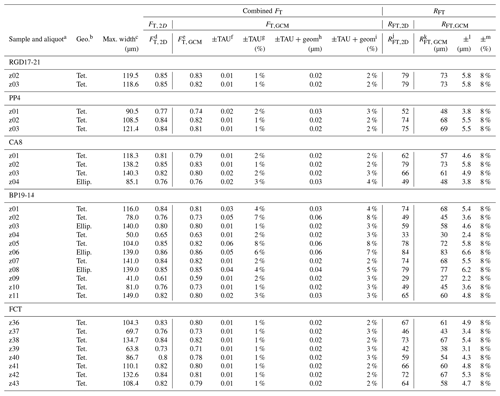
All uncertainties reported at the 1σ level.
All calculations assume FT uncertainties are fully correlated (r=1).
a All RGD17-21, PP4, CA8, and BP19-14 data are published in McGrew and Metcalf (2020), Havranek and Flowers (2022), Basler et al. (2021), and Peak et al. (2023), respectively.
b Geometry is defined as described in Fig. 3 of Ketcham et al. (2011). All GEM A and B grains are tetragonal (tet.) (“tetrahedral prism” of Ketcham et al., 2011), and all GEM C grains are ellipsoidal (ellip.).
c Maximum width is measured perpendicular to the length.
d FT,2D is the combined alpha-ejection correction for the crystal calculated from the 2D parent isotope-specific FT corrections, the proportion of U and Th contributing to the 4He production and assuming homogeneous parent isotope distributions using Eq. (A4) in Cooperdock et al. (2019). The parent isotope-specific alpha-ejection corrections were computed assuming the reported grain geometry in this table and the equations and alpha stopping distances in Ketcham et al. (2011).
e FT,GCM is computed the same as FT,2D but uses isotope-specific FT,GCM values corrected by applying the correction factors in Table 2 based on grain geometry and size.
f The 1σ TAU on FT,GCM. This calculation uses 0 % geometric uncertainty. This value is only used for comparison and only includes the uncertainties on parent isotopes. It is not used in any further calculations.
g The 1σ total analytical percent uncertainty in FT,GCM.
h The 1σ TAU + geometric uncertainty. This uncertainty includes the total analytical uncertainty and uses the parent isotope-specific FT,GCM uncertainties assigned based on grain geometry and size (Table 2).
i The 1σ total analytical + geometric percent uncertainty in FT,GCM.
j RFT,2D is the radius of a sphere with an equivalent alpha-ejection correction as the grain, calculated using the uncorrected parent isotope-specific FT values in Eq. (A6) in Cooperdock et al. (2019).
k RFT,GCM is computed from RFT,2D by multiplying RFT,2D by the correction factor in Table 2 based on grain geometry.
l The 1σ uncertainty in RFT,GCM is assigned based on grain geometry (Table 2).
m The 1σ percent uncertainty in RFT,2D.
Table D3Results of applying geometric corrections and uncertainties (1σ) to zircon (U–Th) He data from a suite of samples previously dated in the CU TRaIL for corrected zircon (U–Th) He date.
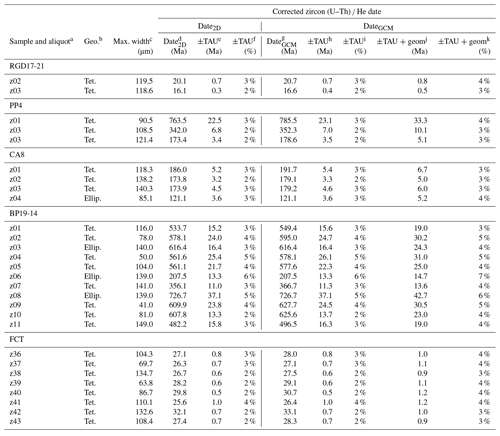
All uncertainties reported at the 1σ level.
All calculations assume FT uncertainties are fully correlated (r=1).
a All RGD17-21, PP4, CA8, and BP19-14 data are published in McGrew and Metcalf (2020), Havranek and Flowers (2022), Basler et al. (2021), and Peak et al. (2023), respectively.
b Geometry is defined as described in Fig. 3 of Ketcham et al. (2011). All GEM A and B grains are tetragonal (tet.) (“tetrahedral prism” of Ketcham et al., 2011), and all GEM C grains are ellipsoidal (ellip.).
c Maximum width is measured perpendicular to the length.
d The corrected (U–Th) He date2D is calculated iteratively using the absolute values of He, U, Th, Sm, the isotope-specific FT,2D values, and Eq. (34) in Ketcham et al. (2011), assuming secular equilibrium.
e The 1σ TAU uncertainty in date2D includes the propagated total analytical uncertainties in the U, Th, Sm, and He measurements. Uncertainty propagation is done using HeCalc (Martin et al., 2023).
f The 1σ total analytical percent uncertainty in date2D.
g The corrected (U–Th) He dateGCM is computed the same as date2D but uses the isotope-specific FT,GCM values corrected by applying the correction factors in Table 2 based on grain geometry and size.
h The 1σ TAU uncertainty in the corrected (U–Th) He dateGCM includes the propagated total analytical uncertainties in the U, Th, Sm, and He measurements. This calculation uses 0 % geometric uncertainty. Uncertainty propagation is done using HeCalc (Martin et al., 2023).
i The 1σ total analytical percent uncertainty in the corrected (U–Th) He dateGCM.
j The 1σ total analytical + geometric uncertainty in the corrected (U–Th) He dateGCM. This uncertainty includes the propagated total analytical uncertainties in the U, Th, Sm, and He measurements and uses the parent isotope-specific FT,GCM uncertainties assigned based on grain geometry and size (Table 2).
k The 1σ total analytical + geometric percent uncertainty in the corrected (U–Th) He dateGCM.
Raw data, photomicrographs of all zircon crystals used in this study, and code used to produce the corrections, uncertainties, and figures are stored through the Open Science Framework https://doi.org/10.17605/OSF.IO/QRK4J (Zeigler et al., 2024). All analyses and plots were done in R (R Core Team, 2023; Wickham et al., 2019).
RMF and JRM conceptualized the project. MB and SDZ curated the data. MB, SDZ, and JRM performed the formal data analysis. RMF, JRM, and SDZ acquired funding. MB performed the investigation. JRM, SDZ, MB, and RMF developed the methodology. RMF provided supervision. MB and SDZ performed the validation. SDZ and MB did the data visualizations. MB, SDZ, and RMF wrote the original draft. RMF, SDZ, MB, and JRM reviewed and edited the paper.
The contact author has declared that none of the authors has any competing interests.
Publisher's note: Copernicus Publications remains neutral with regard to jurisdictional claims made in the text, published maps, institutional affiliations, or any other geographical representation in this paper. While Copernicus Publications makes every effort to include appropriate place names, the final responsibility lies with the authors.
We would like to thank Brian Mahoney and Jacky Baughman for samples. We are grateful to Adrian Gestos for analyzing our samples on the nano-CT during the pandemic and his continuing guidance and assistance. Florian Hofmann, Willy Guenthner, and an anonymous reviewer provided useful reviews that improved this work. We appreciate Marissa Tremblay's diligent handling of our paper.
This research has been supported by the National Science Foundation Graduate Research Fellowship (grant no. DGE-1650115) to Spencer D. Zeigler. Funding for the Zeiss Xradia Versa X-ray microscope was provided by the National Science Foundation (grant no. CMMI-1726864). Partial funding for analytical costs was provided by the Beverly Sears Graduate Student Grant Fund at CU Boulder to Spencer D. Zeigler.
This paper was edited by Marissa Tremblay and reviewed by Florian Hofmann, William Guenthner, and one anonymous referee.
Armstrong, E. M., Ault, A. K., Kaempfer, J. M., and Guenthner, W. R.: Connecting visual metamictization to radiation damage to expand applications of zircon (U Th)/He thermochronometry, Chem. Geol., 648, 121949, https://doi.org/10.1016/j.chemgeo.2024.121949, 2024.
Ault, A. K., Guenthner, W. R., Moser, A. C., Miller, G. H., and Refsnider, K. A.: Zircon grain selection reveals (de)coupled metamictization, radiation damage, and He diffusivity, Chem. Geol., 490, 1–12, https://doi.org/10.1016/j.chemgeo.2018.04.023, 2018.
Basler, L. C., Baughman, J. S., Fame, M. L., and Haproff, P. J.: Spatially variable syn- and post-Alleghanian exhumation of the central Appalachian Mountains from zircon (U-Th) He thermochronology, Geosphere, 17, 1151–1169, https://doi.org/10.1130/GES02368.1, 2021.
Baughman, J. S., Flowers, R. M., Metcalf, J. R., and Dhansay, T.: Influence of radiation damage on titanite He diffusion kinetics, Geochim. Cosmochim. Ac., 205, 50–64, https://doi.org/10.1016/j.gca.2017.01.049, 2017.
BIPM, IEC, IFCC, ILAC, ISO, IUPAC, IUPAP, and OIML: International vocabulary of metrology – Basic and general concepts and associated terms (VIM), https://www.bipm.org/documents/20126/2071204/JCGM_200_2012.pdf/f0e1ad45-d337-bbeb-53a6-15fe649d0ff1 (last access: 29 November 2023), 2012.
Cooperdock, E. H. G., Ketcham, R. A., and Stockli, D. F.: Resolving the effects of 2-D versus 3-D grain measurements on apatite (U–Th) He age data and reproducibility, Geochronology, 1, 17–41, https://doi.org/10.5194/gchron-1-17-2019, 2019.
Danišík, M., Ponomareva, V., Portnyagin, M., Popov, S., Zastrozhnov, A., Kirkland, C. L., Evans, N. J., Konstantinov, E., Hauff, F., and Garbe-Schönberg, D.: Gigantic eruption of a Carpathian volcano marks the largest Miocene transgression of Eastern Paratethys, Earth Planet. Sc. Lett., 563, 116890, https://doi.org/10.1016/j.epsl.2021.116890, 2021.
Dobson, K. J., Stuart, F. M., and Dempster, T. J.: U and Th zonation in Fish Canyon Tuff zircons: Implications for a zircon (U–Th)/He standard, Geochim. Cosmochim. Ac., 72, 4745–4755, https://doi.org/10.1016/j.gca.2008.07.015, 2008.
Evans, N. J., McInnes, B. I. A., Squelch, A. P., Austin, P. J., McDonald, B. J., and Wu, Q.: Application of X-ray micro-computed tomography in (U–Th)/He thermochronology, Chem. Geol., 257, 101–113, https://doi.org/10.1016/j.chemgeo.2008.08.021, 2008.
Farley, K. A., Wolf, R. A., and Silver, L. T.: The effects of long alpha-stopping distances on (U/Th)/He ages, Geochim. Cosmochim. Ac., 60, 4223–4229, https://doi.org/10.1016/S0016-7037(96)00193-7, 1996.
Flowers, R. M., Macdonald, F. A., Siddoway, C. S., and Havranek, R.: Diachronous development of Great Unconformities before Neoproterozoic Snowball Earth, P. Natl. Acad. Sci. USA, 117, 10172–10180, https://doi.org/10.1073/pnas.1913131117, 2020.
Flowers, R. M., Zeitler, P. K., Danišík, M., Reiners, P. W., Gautheron, C., Ketcham, R. A., Metcalf, J. R., Stockli, D. F., Enkelmann, E., and Brown, R. W.: (U-Th) He chronology: Part 1. Data, uncertainty, and reporting, GSA Bull., 135, 104–136, https://doi.org/10.1130/B36266.1, 2022.
Ginster, U., Reiners, P. W., Nasdala, L., and Chanmuang N. C.: Annealing kinetics of radiation damage in zircon, Geochim. Cosmochim. Ac., 249, 225–246, https://doi.org/10.1016/j.gca.2019.01.033, 2019.
Gleadow, A., Harrison, M., Kohn, B., Lugo-Zazueta, R., and Phillips, D.: The Fish Canyon Tuff: A new look at an old low-temperature thermochronology standard, Earth Planet. Sc. Lett., 424, 95–108, https://doi.org/10.1016/j.epsl.2015.05.003, 2015.
Glotzbach, C., Lang, K. A., Avdievitch, N. N., and Ehlers, T. A.: Increasing the accuracy of (U-Th(-Sm))/He dating with 3D grain modelling, Chem. Geol., 506, 113–125, https://doi.org/10.1016/j.chemgeo.2018.12.032, 2019.
Guenthner, W. R., Reiners, P. W., Ketcham, R. A., Nasdala, L., and Giester, G.: Helium diffusion in natural zircon: Radiation damage, anisotropy, and the interpretation of zircon (U-Th) He thermochronology, Am. J. Sci., 313, 145–198, https://doi.org/10.2475/03.2013.01, 2013.
Guenthner, W. R., Reiners, P. W., and Chowdhury, U.: Isotope dilution analysis of Ca and Zr in apatite and zircon (U-Th) He chronometry, Geochem. Geophys. Geosyst., 17, 1623–1640, https://doi.org/10.1002/2016GC006311, 2016.
Havranek, R. E. and Flowers, R. M.: Zircon (U-Th) He data for the Colorado Front Range “fourteeners” and testing Cryogenian exhumation of sub-Great Unconformity basement, Chem. Geol., 591, 120702, https://doi.org/10.1016/j.chemgeo.2021.120702, 2022.
Hawkins, D. P., Bowring, S. A., Ilg, B. R., Karlstrom, K. E., and Williams, M. L.: U-Pb geochronologic constraints on the Paleoproterozoic crustal evolution of the Upper Granite Gorge, Grand Canyon, Arizona, Geol. Soc. Am. B., 108, 1167–1181, https://doi.org/10.1130/0016-7606(1996)108<1167:UPGCOT>2.3.CO;2, 1996.
He, J. J. Y. and Reiners, P. W.: A revised alpha-ejection correction calculation for (U–Th) He thermochronology dates of broken apatite crystals, Geochronology, 4, 629–640, https://doi.org/10.5194/gchron-4-629-2022, 2022.
Herman, F., Braun, J., Senden, T. J., and Dunlap, W. J.: (U–Th)/He thermochronometry: Mapping 3D geometry using micro-X-ray tomography and solving the associated production–diffusion equation, Chem. Geol., 242, 126–136, https://doi.org/10.1016/j.chemgeo.2007.03.009, 2007.
Hoffman, P. F.: Precambrian geology and tectonic history of North America, in: The Geology of North America – An Overview, edited by: Bally, A. W. and Palmer, A. R., Geological Society of America, 447–512, https://doi.org/10.1130/DNAG-GNA-A.447, 1989.
Holland, H. D. and Gottfried, D.: The effect of nuclear radiation on the structure of zircon, Acta Cryst., 8, 291–300, https://doi.org/10.1107/S0365110X55000947, 1955.
Hourigan, J. K., Reiners, P. W., and Brandon, M. T.: U-Th zonation-dependent alpha-ejection in (U-Th) He chronometry, Geochim. Cosmochim. Ac., 69, 3349–3365, https://doi.org/10.1016/j.gca.2005.01.024, 2005.
Ketcham, R. A.: Computational methods for quantitative analysis of three-dimensional features in geological specimens, Geosphere, 1, 32–41, https://doi.org/10.1130/GES00001.1, 2005.
Ketcham, R. A., Gautheron, C., and Tassan-Got, L.: Accounting for long alpha-particle stopping distances in (U–Th–Sm)/He geochronology: Refinement of the baseline case, Geochim. Cosmochim. Ac., 75, 7779–7791, https://doi.org/10.1016/j.gca.2011.10.011, 2011.
Martin, P. E., Metcalf, J. R., and Flowers, R. M.: Calculation of uncertainty in the (U–Th) He system, Geochronology, 5, 91–107, https://doi.org/10.5194/gchron-5-91-2023, 2023.
McGrew, A. J. and Metcalf, J. M.: A Revised Cooling and Extensional Exhumation History for the Harrison Pass Pluton, Southern Ruby Mountains Metamorphic Core Complex, Elko County, Nevada, Vision for Discovery: Geology and Ore Deposits of the Great Basin, Geological Society of Nevada 2020 Symposium Proceedings, online, 2020.
Orme, D. A., Guenthner, W. R., Laskowski, A. K., and Reiners, P. W.: Long-term tectonothermal history of Laramide basement from zircon–He age-eU correlations, Earth Planet. Sc. Lett., 453, 119–130, https://doi.org/10.1016/j.epsl.2016.07.046, 2016.
Peak, B. A., Flowers, R. M., Macdonald, F. A., and Cottle, J. M.: Zircon (U-Th) He thermochronology reveals pre-Great Unconformity paleotopography in the Grand Canyon region, USA, Geology, 49, 1462–1466, https://doi.org/10.1130/G49116.1, 2021.
Peak, B. A., Flowers, R. M., and Macdonald, F. A.: Ediacaran-Ordovician tectonic and geodynamic drivers of Great Unconformity exhumation on the southern Canadian Shield, Earth Planet. Sc. Lett., 619, 118334, https://doi.org/10.1016/j.epsl.2023.118334, 2023.
Rahl, J. M., Reiners, P. W., Campbell, I. H., Nicolescu, S., and Allen, C. M.: Combined single-grain (U-Th) He and U/Pb dating of detrital zircons from the Navajo Sandstone, Utah, Geology, 31, 761–764, https://doi.org/10.1130/G19653.1, 2003.
R Core Team: R: A Language and Environment for Statistical Computing, R Foundation for Statistical Computing, Vienna, Austria, https://www.R-project.org/ (last access: 8 December 2023), 2023.
Reiners, P., Campbell, I., Nicolescu, S., Allen, C. M., Hourigan, J. K., Garver, J., Mattinson, J., and Cowan, D.: (U-Th)/(He-Pb) double dating of detrital zircons, Am. J. Sci., 305, 259–311, 2005.
Reiners, P. W., Farley, K. A., and Hickes, H. J.: He diffusion and (U–Th)/He thermochronometry of zircon: initial results from Fish Canyon Tuff and Gold Butte, Tectonophysics, 349, 297–308, https://doi.org/10.1016/S0040-1951(02)00058-6, 2002.
Schmitz, M. D. and Bowring, S. A.: U-Pb zircon and titanite systematics of the Fish Canyon Tuff: an assessment of high-precision U-Pb geochronology and its application to young volcanic rocks, Geochim. Cosmochim. Ac., 65, 2571–2587, https://doi.org/10.1016/S0016-7037(01)00616-0, 2001.
Stockli, D. F. and Najman, Y. M. R.: Earth's Dynamic Past Revealed by Detrital Thermochronometry, Elements, 16, 311–317, https://doi.org/10.2138/gselements.16.5.311, 2020.
Sturrock, C. P., Flowers, R. M., Kohn, B. P., and Metcalf, J. R.: Phanerozoic Burial and Erosion History of the Southern Canadian Shield from Apatite (U-Th) He Thermochronology, Minerals, 14, 57, https://doi.org/10.3390/min14010057, 2024.
Suriano, J., Lossada, A. C., Mahoney, J. B., Tedesco, A. M., Limarino, C. O., Giambiagi, L. B., Mazzitelli, M. A., Mescua, J. F., Lothari, L., and Quiroga, R.: The southern extension of the Eocene Andean orogeny: New sedimentary record of the foreland basin in the southern Central Andes at 32° S, Basin Res., 35, 2381–2400, https://doi.org/10.1111/bre.12803, 2023.
Unruh, D. M., Snee, L. W., Foord, E. E., and Simmons, W. B.: Age and cooling history of the Pikes Peak batholith and associated pegmatites, in: Geological Society of America Abstracts with Programs, 468, 1995.
Wickham, H., Averick, M., Bryan, J., Chang, W., McGowan, L. D., François, R., Grolemund, G., Hayes, A., Henry, L., Hester, J., Kuhn, M., Pedersen, T. L., Miller, E., Bache, S. M., Müller, K., Ooms, J., Robinson, D., Seidel, D. P., Spinu, V., Takahashi, K., Vaughan, D., Wilke, C., Woo, K., and Yutani, H.: Welcome to the tidyverse, J. Open Source Softw., 4, 1686, https://doi.org/10.21105/joss.01686, 2019.
Wright, J. E. and Snoke, A. W.: Tertiary magmatism and mylonitization in the Ruby-East Humboldt metamorphic core complex, northeastern Nevada: U-Pb geochronology and Sr, Nd, and Pb isotope geochemistry, GSA Bull., 105, 935–952, https://doi.org/10.1130/0016-7606(1993)105<0935:TMAMIT>2.3.CO;2, 1993.
Zeigler, S. D., Metcalf, J. R., and Flowers, R. M.: A practical method for assigning uncertainty and improving the accuracy of alpha-ejection corrections and eU concentrations in apatite (U–Th) He chronology, Geochronology, 5, 197–228, https://doi.org/10.5194/gchron-5-197-2023, 2023.
Zeigler, S. D., Baker, M., Flowers, R. M., and Metcalf, J.: Supplemental Data for: The Geometric Correction Method for Zircon (U-Th)/He Chronology: Correcting Systematic Error and Assigning Uncertainties to Alpha-Ejection Corrections and eU Concentrations, OSF [data set], https://doi.org/10.17605/OSF.IO/QRK4J, 2024.
- Abstract
- Introduction
- Selecting and characterizing a representative zircon suite
- Measurement and data reduction methods
- Results
- Discussion
- Conclusions
- Appendix A
- Appendix B: Additional sample and method information
- Appendix C: Additional regression and uncertainty information
- Appendix D: Application of geometric parameter corrections and uncertainties to a real dataset
- Code and data availability
- Author contributions
- Competing interests
- Disclaimer
- Acknowledgements
- Financial support
- Review statement
- References
- Abstract
- Introduction
- Selecting and characterizing a representative zircon suite
- Measurement and data reduction methods
- Results
- Discussion
- Conclusions
- Appendix A
- Appendix B: Additional sample and method information
- Appendix C: Additional regression and uncertainty information
- Appendix D: Application of geometric parameter corrections and uncertainties to a real dataset
- Code and data availability
- Author contributions
- Competing interests
- Disclaimer
- Acknowledgements
- Financial support
- Review statement
- References





